| |
|
The Stonhams are a
group of three parishes to the north of Needham Market
along the Stowmarket to Yoxford road. The speed trap at
the crossroads where this crosses the A120 through
Stonham Parva seems to have caught just about everyone
who uses that road regularly - just think of how many
points it has put on East Anglian driving licences! But
there are two other Stonhams. Stonham Aspal is further up
the A1120 towards Framlingham, and is home to the famous
Stonham Barns. But the least known of the three is Earl
Stonham, despite the fact that it has one of the most
interesting parish churches in the middle part of the
county.
St Mary is that rare thing in East Anglia, a grand
cruciform church with a clerestory but no aisles and a
15th century west tower, resting sedately in the middle
of a large graveyard. It is such a handsome building that
the grey cement rendering on the lower part of the nave
seems unfortunate. As you walk up the long path towards
the church, the overwhelming impression is of the
beautiful clerestory above it picked out with flint
flushwork. The great west door is original, its intricate
patternwork weathered by the centuries. But you enter
through the south door, via a simple porch.
You step into a long, narrow interior which can seem a
bit gloomy on a dull day, but well cared for and neat and
tidy. Still, with the lack of aisles, and the way that
the clerestory makes the nave lighter above our heads
than at eye level, the impulse is to look up, and see one
of the best double hammerbeam roofs in East Anglia, and
indeed in all England. It was once thought that the rich
red colour was a result of it being made of chestnut, but
in fact this roof is oak. The intricate carvings are warm
and glorious. Alternate hammerbeams are false ones, for
decoration, and these are the ones with the pendant
pineapple decorations. Angels flank the wall plates,
symbols and green men look down leeringly, while above
them animals sport in the foliage of the spandrels.
 
 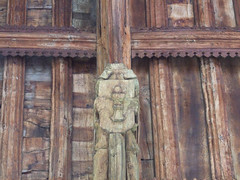 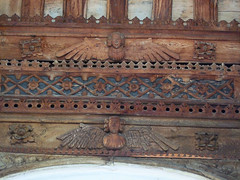
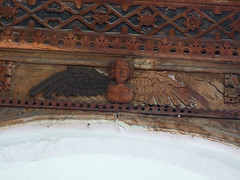 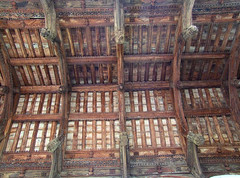 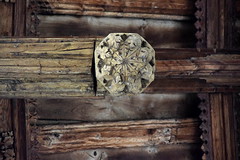
The font sits grandly
now that the space around it has been cleared. It is a
slightly battered twin to that at nearby Creeting St
Peter, and perhaps the recutting of the font there was
based on this one. From here, the eye is led towards the
crossing. Ahead, the chancel is slighter than the two
transepts and Victorian in character, appearing to float,
full of colour and light, above the nave.
Above the chancel arch are the remains of a doom
painting. It shows the Last Judgement, with souls being
measured, and then sent south to Hell or north to Heaven.
The middle part of the painting is almost empty,
suggesting that the rood went up this high. It would have
been lit by the small quatrefoil window near the roof of
the north transept, which now contains what appears to be
a panel of continental glass depicting a cockerel and a
crown of thorns, presumably once part of an Instruments
of the Passion sequence.
On the west wall of the south transept is a painting, a
scene from St George and the Dragon. It is unfortunately
cut off by the organ, making it difficult to photograph,
but the king standing on his castle tower to watch the
saint defeat the dragon is very clear. Opposite, until
the 1930s, it was still possible to discern what appeared
to be the martyrdom of St Thomas of Canterbury. This is a
rare subject in East Anglia. Another wall painting, in
the south transept, showed the Nativity, and was probably
part of a sequence like that at North Cove or Wissington.
It has been whitewashed again, but a modern transcript of
an 1870s copy is on display.
There are also medieval benches, and one opposite the
door bears a dedicatory inscription: Orate pro
[anima] Necolai Houk ('Pray for [the soul of]
Nicolas Hook'). The pulpit here has a series of three
egg-timers behind it, with which an 18th century preacher
could keep tabs on the length of his sermon. Simon
Jenkins says that they were intended to make sure he
didn't cut it short, rather than to stop him going on too
long. They time a quarter, half and three-quarters of an
hour. Stepping up into the chancel, There's some good
19th century carving, but some medieval carvings too,
four stall ends including a bagpiper, rather different
from the same thing at Honington. The others are very
damaged, but appear to be a woodcutter with an axe, a
woodwose and a devil. All of them have had their faces
slided off, presumably in the 1540s.
  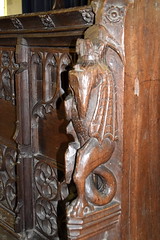 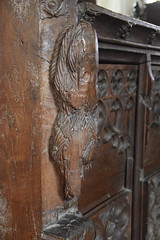
Back in 2000, when
most churches had the pleasant luxury of deciding what
their Millennium project should be, the parish here had
rather more pressing concerns. The bell tower was
beginning to separate from the back of the church, and so
drastic renovation work was needed to both the tower and
the bells themselves. As part of this project, the
ringing chamber was lowered to be in full view of the
congregation, a kitchen and toilet were added to the
vestry area, and the medieval pews were moved to the
north transept before the war memorial chapel to create a
quiet area for contemplation.
Today, St Mary is an utterly lovely church which, despite
its size, has a homely feel. Beneath the great roof, the
light falls through ancient window tracery onto simple,
devotional fittings. The deep silence of the wide
graveyard fills the interior, a space which it is always
a pleasure to visit, and to explore, and to just sit and
be still in the presence of something beyond our everyday
material existence.
Simon
Knott, November 2019
Follow these journeys as they happen at Last Of England
Twitter.
 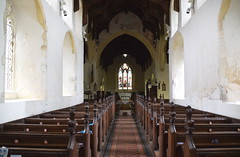 
   
 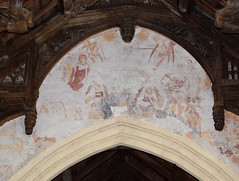 
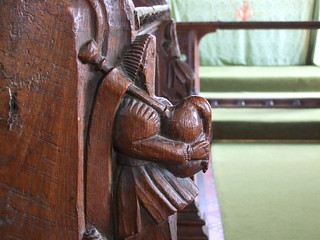
Amazon commission helps cover the running
costs of this site
|
|
|

